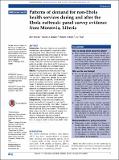| dc.contributor.author | Morse, Benjamin Sherman | |
| dc.contributor.author | Grépin, Karen A. | |
| dc.contributor.author | Blair, Robert A. | |
| dc.contributor.author | Tsai, Lily L. | |
| dc.date.accessioned | 2016-07-13T20:17:04Z | |
| dc.date.available | 2016-07-13T20:17:04Z | |
| dc.date.issued | 2016-05 | |
| dc.date.submitted | 2016-03 | |
| dc.identifier.issn | 2059-7908 | |
| dc.identifier.uri | http://hdl.handle.net/1721.1/103595 | |
| dc.description.abstract | Introduction: The recent Ebola virus disease (EVD) outbreak was unprecedented in magnitude, duration and geographic scope. Hitherto there have been no population-based estimates of its impact on non-EVD health outcomes and health-seeking behaviour.
Methods: We use data from a population-based panel survey conducted in the late-crisis period and two postcrisis periods to track trends in (1) the prevalence of adult and child illness, (2) subsequent usage of health services and (3) the determinants thereof.
Results: The prevalence of child and adult illness remained relatively steady across all periods. Usage of health services for children and adults increased by 77% and 104%, respectively, between the late-crisis period and the postcrisis periods. In the late-crisis period, (1) socioeconomic factors weakly predict usage, (2) distrust in government strongly predicts usage, (3) direct exposure to the EVD outbreak, as measured by witnessing dead bodies or knowing Ebola victims, negatively predicts trust and usage and (4) exposure to government-organised community outreach predicts higher trust and usage. These patterns do not obtain in the post-crisis period.
Interpretation: Supply-side and socioeconomic factors are insufficient to account for lower health-seeking behaviour during the crisis. Rather, it appears that distrust and negative EVD-related experiences reduced demand during the outbreak. The absence of these patterns outside the crisis period suggests that the rebound after the crisis reflects recovery of demand. Policymakers should anticipate the importance of demand-side factors, including fear and trust, on usage of health services during health crises. | en_US |
| dc.description.sponsorship | Omidyar Network | en_US |
| dc.description.sponsorship | International Growth Centre | en_US |
| dc.description.sponsorship | Massachusetts Institute of Technology. School of Humanities, Arts, and Social Sciences | en_US |
| dc.language.iso | en_US | |
| dc.publisher | BMJ Publishing Group Ltd. | en_US |
| dc.relation.isversionof | http://dx.doi.org/10.1136/bmjgh-2015-000007 | en_US |
| dc.rights | Creative Commons Attribution Non-Commercial License | en_US |
| dc.rights.uri | http://creativecommons.org/licenses/by-nc/4.0/ | en_US |
| dc.source | BMJ | en_US |
| dc.title | Patterns of demand for non-Ebola health services during and after the Ebola outbreak: panel survey evidence from Monrovia, Liberia | en_US |
| dc.type | Article | en_US |
| dc.identifier.citation | Morse, Ben, Karen A Grépin, Robert A Blair, and Lily Tsai. "Patterns of demand for non-Ebola health services during and after the Ebola outbreak: panel survey evidence from Monrovia, Liberia." BMJ Global Health 2016;1:e000007. | en_US |
| dc.contributor.department | Massachusetts Institute of Technology. Department of Political Science | en_US |
| dc.contributor.mitauthor | Morse, Benjamin Sherman | en_US |
| dc.contributor.mitauthor | Tsai, Lily L. | en_US |
| dc.relation.journal | BMJ Global Health | en_US |
| dc.eprint.version | Final published version | en_US |
| dc.type.uri | http://purl.org/eprint/type/JournalArticle | en_US |
| eprint.status | http://purl.org/eprint/status/PeerReviewed | en_US |
| dspace.orderedauthors | Morse, Ben; Grépin, Karen A; Blair, Robert A; Tsai, Lily | en_US |
| dspace.embargo.terms | N | en_US |
| dc.identifier.orcid | https://orcid.org/0000-0002-5264-4655 | |
| mit.license | PUBLISHER_CC | en_US |
| mit.metadata.status | Complete | |
